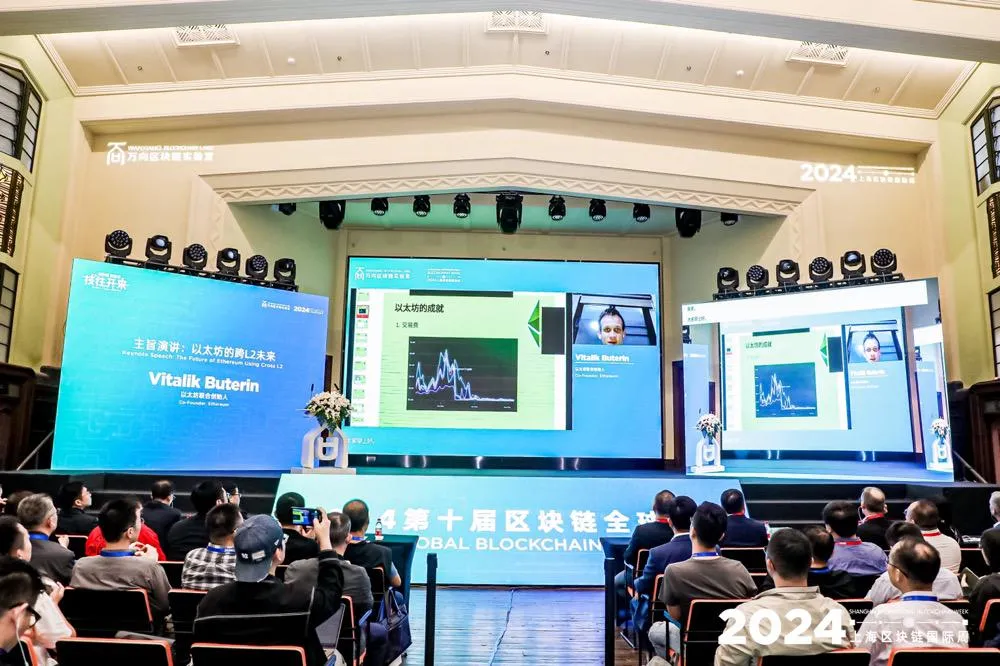Vitalik Buterin: The Future of Ethereum and the Path to Over 100k TPS with L2 Solutions
On October 17, at the 10th Global Blockchain Summit hosted by Wanxiang Blockchain Lab, Ethereum co-founder Vitalik Buterin reflected on Ethereum’s journey and outlined ambitious future goals. He asserted that Ethereum, through Layer 2 (L2) solutions, could achieve over 100,000 transactions per second (TPS) and enable seamless transfers between Ethereum and other chains within two seconds, all while providing a unified user experience.
Additionally, he emphasized the growing importance of security links over the Ethereum Virtual Machine (EVM) in the expansion of Ethereum’s infrastructure.

Key Highlights from Buterin’s Speech:
The Journey of Ethereum
Vitalik began by tracing the history of the Ethereum project, which started in November 2013, with the Ethereum Foundation founded in 2014 and the network launching in July 2015. Over the past decade, the primary focus has been on refining Ethereum’s technology.
Despite discussions remaining consistent over the years—covering scalability, privacy, and security—significant progress has been made.
Transaction Costs and Layer 2 Solutions
Buterin discussed the evolution of transaction fees on Ethereum, highlighting the high costs before L2 solutions were implemented. In 2020 and 2021, transaction fees on Layer 1 could reach as high as $800. However, with the introduction of L2 solutions, fees have dramatically decreased.
He introduced the concept of EIP-4844, which aims to increase data capacity on L2, allowing transaction fees to drop from $0.2 to $0.01. This shift makes transactions significantly more accessible for users and developers.
Transaction Confirmation Speed
Another critical improvement has been the speed of transaction confirmations. While Bitcoin’s average block time is around 10 minutes, Ethereum’s time has varied over the years. Improvements made with the EIP-1559 protocol have led to much quicker confirmation times, often allowing users to see their transactions confirmed almost instantly.
Enhanced User Experience
Buterin illustrated the contrast in user interfaces from 2015 to now. He pointed out that many users in countries like Argentina and Turkey are engaging with digital currencies but not fully utilizing blockchain technology.
Centralized services offer faster and free transactions, leading to a need for Ethereum to improve user interfaces and experiences to attract these users into the decentralized space.
Technological Advancements in Wallets and ZK Proofs
The advancements in smart accounts and account abstraction have also been significant. The development of zero-knowledge (ZK) proofs has improved transaction speeds and capabilities, making functionalities like identity verification more accessible. Wallet user experiences have seen tremendous enhancements, making Ethereum more user-friendly.
Future Goals for Ethereum
Buterin outlined several key objectives for the future of Ethereum:
- Achieving Over 100k TPS with L2: Utilizing innovative approaches to reach this milestone.
- Seamless Transfers: Enabling transfers between any Ethereum-based chain and others within two seconds.
- Unified User Experience: Simplifying interactions across the Ethereum ecosystem.
- Security Links: Prioritizing security links over the EVM, ensuring that chains are protected by Ethereum’s security framework.
With these advancements and ongoing innovations, Buterin encouraged developers to revisit past ideas that may not have succeeded, as current technology could offer new chances for success. The future looks promising for Ethereum, with significant potential to reshape the blockchain landscape.